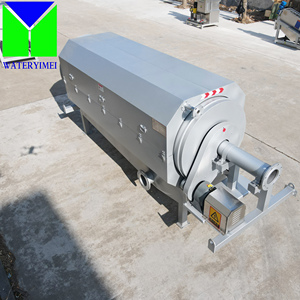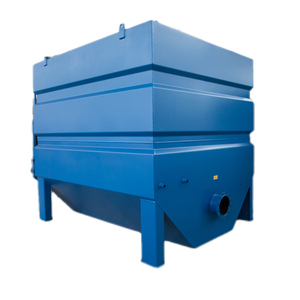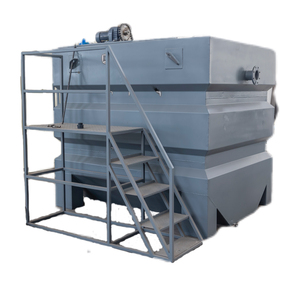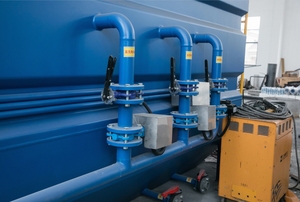(1628 products available)












































































































































































































































A wastewater drum filter is an equipment that uses a cylindrical drum to filter solid particles in wastewater. The drum revolves slowly in the water to perform the filtration process. There are different types of drum filters used for treating wastewater. The following are some of them:
The main specifications of a drum screen filter can include the dimensions, filtration accuracy, flow rate, material, structure, and voltage power.
Dimensions
The dimensions can include the diameter and length. For some models, they can be 500 mm and 1500 m, respectively. However, the dimensions can be customized based on specific requirements or applications.
Filtration accuracy
The precision can be expressed in micron size. Some models can filter particles with a size of 20 micron. It is essential to know that the filtration accuracy is customizable to meet distinct needs.
Flow rate
The flow rate usually indicates the processing ability of the drum filter and can range from 10 m3/h to 100 m3/h or more.
Materials
The common materials are stainless steel and carbon steel. The former can ensure the robustness and longevity of the filter. Additionally, the latter can offer adequate strength and durability for less demanding applications.
Structure
Some models of the filter can adopt a modular structure. That is to say, they have several drums working together. Also, some other models can be with a single drum. The one-drummed design is suitable for small-scale treatment systems.
Voltage
Drum filters can work in different voltage environments, such as 220V, 380V, or other voltages as required.
It is essential to maintain a wastewater drum filter to ensure its normal operation and prolong its service life. The maintenance methods can include cleaning, inspecting, lubricating, and replacing parts.
Cleaning
Users should regularly clean the drum filter to remove dirt, grease, and deposits. According to the manufacturer's instructions, an appropriate cleaning solution or equipment should be used.
Inspection
Users should check the drum screen filter regularly. They should inspect parts such as frames, meshes, and motors to look for any signs of damage, looseness, or corrosion. If any problems are found, they should be repaired or replaced promptly.
Lubrication
Users should lubricate the bearing and transmission part of the drum filter according to the required frequency and quantity of lubricant. It can ensure smooth operation and reduce abrasion and heat generation.
Replacing parts
After prolonged use, some parts of the drum filter may be worn out or damaged, such as the mesh and bearings, etc. Users should replace these parts promptly to ensure the equipment works well.
Wastewater drum filters play a crucial role in numerous applications, most of which are downstream water sources.
Municipal Water Treatment Facilities
Large-scale wastewater treatment plants employ commercial/industrial wastewater filters to extract larger solids from effluent before it goes through the subsequent treatment phases. These filters curb strain on dependent treatment methodologies benefitting the entire community downstream.
Food and Beverage Industry
Food and beverage manufacturing companies produce large volumes of wastewater laden with organic materials and food particles when processing edible goods. Wastewater drum filters come in handy to separate food remnants thus enabling subsequent treatment processes, while at the same time allowing for recovery of valuable products such as whey or juice.
Pulp and Paper Industry
Paper manufacturing plants generate cellulose fibers, filling agents, and paper chemicals from pulp processing and paper products. These plants install drum filters in wastewater treatment systems to remove fibrous residues, chemicals, and other contaminants before discharging treated water into nearby sources or reuse it for irrigation within the facility's perimeter.
Mining and Metallurgy
Mining companies are always on the lookout for ways to separate solids from leachate and process water. Wastewater drum filters mine valuable minerals from process water and tailings. This is made possible while at the same time treating contaminated effluent. The filters achieve this by eliminating sediments, heavy metals, and chemicals from the filtered water. The removed contaminants are usually harmful to humans and aquatic life, hence the need to get rid of them as per environmental regulations.
Textile and Dyeing Facilities
Dyeing and textile manufacturing processes produce coloured and chemical-laden effluent which contains dyes, chemicals, and fibers. Wastewater drum filters stand in as the first line of defence by extracting these troublesome pollutants. The extracted dyes and chemicals are later treated separately so as to ensure that the final treated water is safe before human consumption.
Aquaculture
Traditional fish farming companies are faced with the challenge of properly disposing of effluent rich in organic substances and nutrients.. Wastewater drum filters offer an efficient solution by extracting uneaten feed and fish waste from the effluent, thus reducing pollution and minimizing environmental impact.
Swimming Pools
Pools in hotels, gyms and recreation centres are constantly monitored and maintained so as to keep visitors safe. Drum filters in the pool's wastewater system help separate pool users debris; such as hair, body lotions, and make-up, from the pool water before it goes through the treatment and recirculation system. This improves the quality of the filtered water and lowers the load on treatment chemicals and disinfectants.
Choosing the right drum filters requires careful consideration of various factors to ensure that the selected drum screen will perform well and meet the needs of the specific wastewater treatment application. Here are some steps to help decide which wastewater drum filters to choose for a particular use.
Q1: How does the external energy-driven drum filter work?
A1: An external energy-driven filter performs a similar task to a passive drum filter, but instead of relying on the water's flow to turn the drum, an external energy source or driver turns it. This driver may be an electric motor connected to a gearbox that feeds the drum, thus providing a constant filtering capacity irrespective of changes in water flow.
Q2: How does the ultraviolet drum filter work?
A2: An ultraviolet drum filter has the same configuration as a passive drum filter but with a UV lamp inside the drum. The lamp can be powered on only when the drum is turning, thereby exposing only those effluents in direct contact with the UV rays to the contaminants. This process can help reduce the use of chemicals.
Q3: How does the cologne drum filter work?
A3: A cologne drum filter works similarly to a passive drum filter by moving the effluents through the cotton cloth attached to the drum. The cologne in the drum container helps the contaminants adhere to the cloth. After the cloth is saturated, it has to be replaced for the process to be repeated.